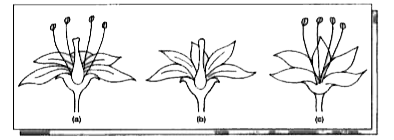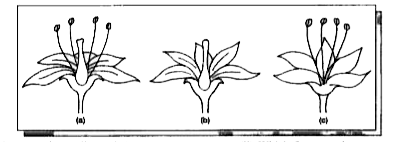Study the data of the following three categories A, B and C.

(i) from the given three categories A, B and C, pick the one which forms Dobereiner.s Triads.
(ii) Why did Mendeleev placed elements of category A, B and C in three different groups?
(iii) Is Newland law of octaves applicable to all the three categories? Give reason to justify your answer.
(i) Category A forms triad, (7+39)/2=23.
(ii) Mendeleev based his periodic table on the law that properties of elements are periodic function of atomic masses.
He sorted out the elements with similar properties and grouped them together. Li, Na and K has similar properties, they were grouped together. N, P and As had similar properties they were grouped together. Similarly, B, Al and Ga has similar properties, they were grouped together.
(iii) Newlands law of octaves was applicable upto calcium. After calcium, every eighth element did not have properties similar to the first. Therefore we can say that elements of category A follows Newlands law.
Topper's Solved these Questions
- BOOK - U-LIKE SERIESCHAPTER - CBSE EXAMINATION PAPER 2020 (SOLVED)EXERCISE - SECTION C9videos
CBSE EXAMINATION PAPER 2020 (SOLVED)
- BOOK - U-LIKE SERIESCHAPTER - CBSE EXAMINATION PAPER 2020 (SOLVED)EXERCISE - SECTION C9videos
CBSE EXAMINATION PAPER 2020 (SOLVED)
- BOOK - U-LIKE SERIESCHAPTER - CARBON AND ITS COMPOUNDS EXERCISE - LONG ANSWER QUESTIONS4videos
CARBON AND ITS COMPOUNDS
- BOOK - U-LIKE SERIESCHAPTER - CHEMICAL REACTIONS AND EQUATIONS EXERCISE - LONG ANSWER QUESTIONS21videos
CHEMICAL REACTIONS AND EQUATIONS
Similar Questions
Knowledge Check
- Question 1 - Select One
Study the pathway given below :
In which of the following options correct words for all the three blanks a,b, and c are indicated.
 Aa-Decarboxylation,b-Reduction,c-RegeneationBa-Fixation,b-Transamination,c-RegenerationCa-Fixation,b-Decarboxylation,c-RegenerationDa-Carboxylation,b-Decarboxylation,c-Reduction
Aa-Decarboxylation,b-Reduction,c-RegeneationBa-Fixation,b-Transamination,c-RegenerationCa-Fixation,b-Decarboxylation,c-RegenerationDa-Carboxylation,b-Decarboxylation,c-Reduction - Question 2 - Select One
Which of the following states that properties of elements are a periodic function of their atomic number''?
A) Dobereiner's triads
B) Modern periodic law
C) Newlands's law of octaves
D) Mendeleev's periodic lawADobereiner's triadsBModern periodic lawCNewlands's law of octavesDMendeleev's periodic law
The position of three elements A, B and C in the Modern periodic table is as follows :

Write formula of compound formed between :
(i) B and A,
(ii) B and C
(b) Is any of the three elements a metal ? Give reason to justify your answer.View SolutionThe atomic numbers of three elements A,B and C are given below:
Element Atomic
A3
B9
C11
Giving reasons state, which two elements will show similar chemical properties.View SolutionStudy the three flowers (a), (b) and (c) in the following figures. Then answer the questions (by writing letter )

Which flower makes pollen only?View SolutionStudy the three flowers (a), (b) and (c) in the following figures. Then answer the questions (by writing letter )

Which flower makes pollen and eggs?View SolutionBacteria are grouped under four categories based on their shape . Study the given figures and identify A, B, C and D.
 View Solution
View SolutionStudy the three flowers (a), (b) and (c) in the following figures. Then answer the questions (by writing letter )

Which flower makes eggs only?View Solution


